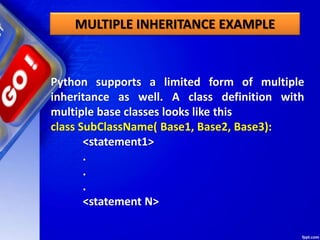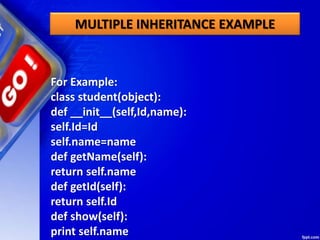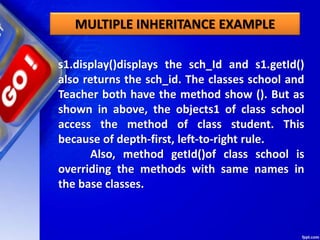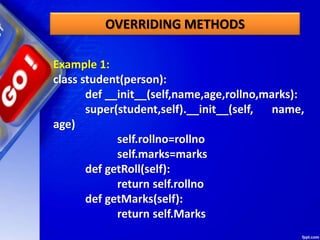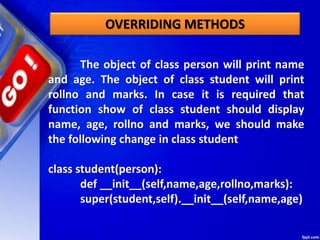Chapter 07 inheritance
- 1. CHAPTER - 07 EXTENDING CLASSES - INHERITANCE
- 2. Unit I Programming and Computational Thinking (PCT-2) (80 Theory + 70 Practical) DCSc & Engg, PGDCA,ADCA,MCA.MSc(IT),Mtech(IT),MPhil (Comp. Sci) Department of Computer Science, Sainik School Amaravathinagar Cell No: 9431453730 Praveen M Jigajinni Prepared by Courtesy CBSE Class XII
- 4. INHERITANCE In object oriented programming, inheritance is a mechanism in which a new class is derived from an already defined class. The derived class is known as a subclass or a child class. The pre-existing class is known as base class or a parent class or a super class. The mechanism of inheritance gives rise to hierarchy in classes. The major purpose of inheriting a base class into one or more derived class is code reuse.
- 5. INHERITANCE - OVERRIDING What is Overriding? The subclass inherits all the methods and properties of the super class. The subclass can also create its own methods and replace methods of the superclass. The process of replacing methods defined in super with new methods with same name in the derived class is known as overriding.
- 6. TYPES OF INHERITANCE Inheritance can be categorised into five types: 1. SINGLE INHERITANCE 2. MULTILEVEL INHERITANCE 3. MULTIPLE INHERITANCE 4. HIERARCHICAL INHERITANCE 5. HYBRID INHERITANCE
- 7. 1. SINGLE INHERITANCE This is the simplest kind of inheritance. In this, a subclass is derived from a single base class. BASE DERIVED
- 8. 2. MULTILEVEL INHERITANCE In this type of inheritance, the derived class becomes the base of another class. BASE 1 DERIVED BASE 2
- 9. 3. MULTIPLE INHERITANCE BASE 1 DERIVED BASE 2 In this type of inheritance, the derived class inherits from one or more base classes.
- 10. 4. HIERARCHICAL INHERITANCE In this type of inheritance, the base class is inherited by more than one class. BASE 1 DERIVED 2DERIVED 1
- 11. 5. HYBRID INHERITANCE This inheritance is a combination of multiple, hierarchical and multilevel inheritance. BASE 1 BASE 2 DERIVED 2DERIVED 1
- 13. EXAMPLES ON INHERITANCE Syntax: class subclass (super): For Example class person: def __init__(self,name,age): self.name=name self.age=age def getName(self): return self.name
- 14. EXAMPLES ON INHERITANCE def getAge(self): return self.Age class student(person): def __init__(self,name,age,rollno,marks): super(student,self)._init_(self, name, age) self.rollno=rollno self.marks=marks def getRoll(self): return self.rollno def getMarks(self): return self.Marks
- 15. EXAMPLES ON INHERITANCE The above example implements single inheritance. The class student extends the class person. The class student adds two instance variables rollno and marks. In order to add new instance variables, the _init_() method defined in class person needs to be extended. The __init__() function of subclass student initializesname and age attributes of superclass person and also create new attributes rollno and marks.
- 16. EXTENDING __init__ () METHOD
- 17. EXTENDING __init__ () METHOD In python the above task of extending __init__ () can be achieved the following ways: i) By using super() function ii) By using name of the super class.
- 18. super() FUNCTION
- 19. super() FUNCTION In the above example, the class student and class person both have __init__ () method. The __init__ () method is defined in cIass person and extended in class student. In Python, super() function is used to call the methods of base class which have been extended in derived class Syntax: super(type, variable) bound object
- 20. super() FUNCTION EXAMPLE class student(person): def __init__(self,name,age,rollno,marks): super(student, self).__init__ (self, name, age) self.rollno=rollno self.marks=marks
- 21. BY USING NAME OF THE SUPER CLASS
- 22. BY USING NAME OF THE SUPER CLASS As discussed above, the class student and class person both have __init__ () method. The __init__ () method is defined in cIass person and extended in class student. In Python, name of the base class can also be used to access the method of the base class which has been extended in derived class.
- 23. BY USING NAME OF THE SUPER CLASS Example class student(person): def __init__(self,name,age,rollno,marks): person.__init__ (self, name, age) self.rollno=rollno self.marks=marks
- 25. MULTIPLE INHERITANCE EXAMPLE Python supports a limited form of multiple inheritance as well. A class definition with multiple base classes looks like this class SubClassName( Base1, Base2, Base3): <statement1> . . . <statement N>
- 26. MULTIPLE INHERITANCE EXAMPLE Python supports a limited form of multiple inheritance as well. A class definition with multiple base classes looks like this class SubClassName( Base1, Base2, Base3): <statement1> . . . <statement N>
- 27. MULTIPLE INHERITANCE EXAMPLE For old-style classes, the only rule is depth-first, left-to-right. Thus, if an attribute is not found in SubClassName, it is searched in Base1, then (recursively) in the base classes of Base1, and only if it is not found there, it is searched in Base2, and so on
- 28. MULTIPLE INHERITANCE EXAMPLE For Example: class student(object): def __init__(self,Id,name): self.Id=Id self.name=name def getName(self): return self.name def getId(self): return self.Id def show(self): print self.name
- 29. MULTIPLE INHERITANCE EXAMPLE print self.Id class Teacher(): def __init__(self,tec_Id,tec_name, subject): self.tec_Id=tec_Id self.tec_name=tec_name self.subject=subject def getName(self): return self.tec_name def getId(self): return self.tec_Id
- 30. MULTIPLE INHERITANCE EXAMPLE def getSubject(self): return self.ubject def show(self): print self. tec_name print self.tec_Id print self.subject class school(student,Teacher): def __init__(self, ID, name, tec_Id, tec_name, subject, sch_Id): student.__init__ (self,ID,name) Teacher. __init__(self,tec_Id,tec_name, subject) self.sch_Id= sch_Id
- 31. MULTIPLE INHERITANCE EXAMPLE def getId(self ): return self.sch_Id def display(self): return self.sch_Id In above example class school inherits class student and teacher. Let us consider these outputs >>> s1=school(3,"Sham",56,"Ram","FIT",530) >>> s1.display() 530
- 32. MULTIPLE INHERITANCE EXAMPLE >>> s1.getId() 530 >>> s1.show() Sham 3 The object of class school takes six instance variables. The first five instance variables have been defined in the base classes (school and Teacher). The sixth instance variable is defined in class school.
- 33. MULTIPLE INHERITANCE EXAMPLE s1.display()displays the sch_Id and s1.getId() also returns the sch_id. The classes school and Teacher both have the method show (). But as shown in above, the objects1 of class school access the method of class student. This because of depth-first, left-to-right rule. Also, method getId()of class school is overriding the methods with same names in the base classes.
- 35. The feature of overriding methods enables the programmer to provide specific implementation to a method in the subclass which is already implemented in the superclass. The version of a method that is executed will be determined by the object that is used to invoke it. If an object of a parent class is used to invoke the method, then the version in the parent class will be executed, but if an object of the subclass is used to invoke the method, then the version in the child class will be executed. OVERRIDING METHODS
- 36. Example 1: class student(person): def __init__(self,name,age,rollno,marks): super(student,self).__init__(self, name, age) self.rollno=rollno self.marks=marks def getRoll(self): return self.rollno def getMarks(self): return self.Marks OVERRIDING METHODS
- 37. def show(self): print self.rollno print self.marks As shown in the above example class student inherits class person. Both the classes have a function show( ). The function show() in student is overriding function show() in person(). OVERRIDING METHODS
- 38. The object of class person will print name and age. The object of class student will print rollno and marks. In case it is required that function show of class student should display name, age, rollno and marks, we should make the following change in class student class student(person): def __init__(self,name,age,rollno,marks): super(student,self).__init__(self,name,age) OVERRIDING METHODS
- 39. self.rollno=rollno self.marks=marks def getRoll(self): return self.rollno def getMarks(self): return self.Marks def show(self): person.show( ) print self.rollno print self.marks OVERRIDING METHODS
- 40. CLASS TEST 1. What is inheritance? 2. What are the types of inheritance? 3. Explain Multiple Inheritance with suitable example 4. What is super? Explain 5. Explain Overriding functions Class : XII Time: 40 Min Topic: Inheritance Max Marks: 20
- 41. Thank You

























